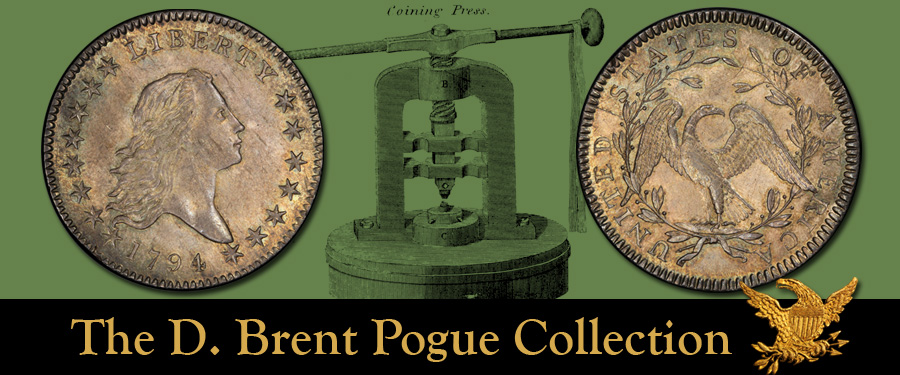
Building a type set of American coinage is a fascinating challenge that has been embarked upon by many people. Such a collection consists of one of each major design minted from 1792 onward. Famous names in this specialty have included Jimmy Hayes and Lelan Rogers, both of whom aspired to acquire the highest quality possible.
Among type coins there are several issues—each superbly represented in the D. Brent Pogue Collection—that are rare in any grade, from worn nearly smooth on up. This list includes such low-mintage coins as the 1796 Draped Bust obverse / Small Eagle reverse quarter dollar, the 1796-1797 half dollar type of the same design, and the 1808 Capped Bust quarter eagle. Each of these is worth many thousands of dollars even if in a grade such as Good-4.
In contrast there is the 1794 half dollar, the coin showcased in this week’s presentation. The Pogue specimen scheduled to appear as lot 1095 in our Part 1 sale in May is Choice Mint State, MS-64 (PCGS), nearly a gem. The mintage of 1794 half dollars was 23,464 coins. Today, hundreds exist, and there is no difficulty in locating an example in low and medium circulated grades.
Mint State is a different thing entirely!
When in 1967 Al C. Overton published what became the definitive reference on the series, Early Half Dollar Die Varieties 1794-1836, the presently-offered Pogue Collection coin was the only 1794 half dollar he knew of in any Mint State range! This remained the situation for years afterward. Today in 2015 there are a few 1794 halves certified in lower Mint State levels.
The first silver coin production at the Mint consisted of 5,300 half dollars and 1,758 silver dollars delivered on October 15, 1794, to the Mint treasurer by chief coiner Henry Voigt. Earlier, Voigt had made dies, but by 1795 that specialty was entrusted to staff engraver Robert Scot. On February 4, 1795, a large batch of 18,164 half dollars was delivered from 1794-dated dies. The silver dollar production of 1794 was an unfortunate affair, as the Mint did not have a press of proper capacity to strike this large-diameter denomination. Accordingly, all known specimens dated 1794 are lightly struck on the star centers at the lower left of the obverse and the corresponding part of reverse. In contrast, there was no problem striking the 1794 half dollars.
Both denominations feature the Flowing Hair obverse design with the Small Eagle reverse. This motif was also used on 1794-dated half dimes, but coins from those dies were not struck until calendar year 1795. By the time that dimes and quarters were first minted, in 1796, the design had changed to the Draped Bust obverse with a differently-styled Small Eagle reverse.
So far as is known, each and every 1794 half dollar was put into circulation. There is no record of any being saved as presentation or other special coins. In time, nearly all became well-worn. The Pogue coin is an exception. By rare chance it seems to have been saved shortly after it was issued. By continuing rare chance in following decades it was carefully preserved. Jimmy Hayes, whose famous type set we auctioned in 1985 and who once owned this coin, remarked to us: “Of all first-year-of-issue United States design types, the 1794 is the rarest in Mint State.”
The buyer of the Pogue Collection 1794 half dollar will have a coin that has been famous for a long time and stands far above any other of its type—a treasure.





